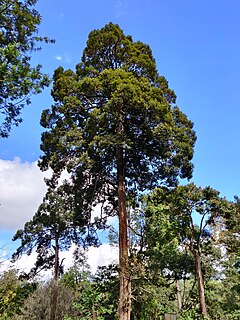
The brown palm civet also called the Jerdon's palm civet is a palm civet endemic to the Western Ghats of India.

The Sri Lanka montane rain forests is an ecoregion found above 1,000 m in the central highlands of Sri Lanka. Owing to their rich biodiversity, this region considered a super-hotspot within the endemism hotspot of global importance. These forests are cooler than lowland forests and therefore they have ideal conditions for growth of cloud forests. These forests classifications tropical sub montane forest, tropical sub-montane and tropical upper montane. Half of Sri Lanka's endemic flowering plants and 51 percent of the endemic vertebrates are restricted to these forests. More than 34 percent of Sri Lanka's endemic trees, shrubs, and herbs can only be found in this ecoregion. Twisted, stunted trees are a common sight in these forests, together with many varieties of orchids, mosses and ferns. The trees of montane rain forests grow to a height 10–15 meters, shorter than the lowland rain forest trees. These high altitude forests are the catchment area for most of Sri Lanka's major rivers.

Cullenia is a genus of flowering plants native to India and Sri Lanka. Earlier classification schemes place the genus in the kapok-tree family (Bombacaceae), but the Angiosperm Phylogeny Group places it in the mallow family (Malvaceae).
Durio ceylanicus, the Ceylon durian, is a species of flowering plant in the family Malvaceae. It is found only in Sri Lanka. The Ceylon durian, a large prickly fruit, is inedible and does not stink.
Dicellostyles axillaris is a species of flowering plant in the family Malvaceae endemic to Sri Lanka. It is the only species in the genus Dicellostyles.
Elaeocarpus glandulifer is a species of flowering plant in the Elaeocarpaceae family. It is endemic to Sri Lanka, mainly in South-western areas.
Hampea reynae, the majagua, is a species of flowering plant in the family Malvaceae. It is endemic to the cloud forests of El Salvador, and was first described in 1980 by Paul Fryxell.
Antidesma pyrifolium is a species of plant in the family Phyllanthaceae. It is endemic to Sri Lanka.
Litsea glaberrima is a species of plant in the family Lauraceae. It is endemic to Sri Lanka.
Litsea iteodaphne is a species of plant in the family Lauraceae. It is endemic to Sri Lanka.
Shorea cordifolia is a species of plant in the family Dipterocarpaceae. It is endemic to Sri Lanka.
Shorea megistophylla is a species of plant in the family Dipterocarpaceae. It is endemic to Sri Lanka.

Shorea zeylanica is a species of plant in the family Dipterocarpaceae. It is endemic to Sri Lanka.
Syzygium makul is a species of plant in the family Myrtaceae. It is endemic to Sri Lanka.
Wildlife of Sri Lanka includes its flora and fauna and their natural habitats. Sri Lanka has one of the highest rates of biological endemism in the world.

The Sri Lanka lowland rain forests represents Sri Lanka's Tropical rainforests below 1,000 m (3,281 ft) in elevation in the southwestern part of the island. The year-around warm, wet climate together with thousands years of isolation from mainland India have resulted in the evolution of numerous plants and animal species that can only be found in rain forests in Sri Lanka. The thick forest canopy is made up of over 150 species of trees, some of the emergent layer reaching as high as 45 m (148 ft). The lowland rain forests accounts for 2.14 percent of Sri Lanka's land area. This ecoregion is the home of the jungle shrew, a small endemic mammal of Sri Lanka. Sri Lanka has the highest density of amphibian species worldwide. Many of these, including 250 species of tree frogs, live in these rain forests.

Central Highlands of Sri Lanka is a recognised world Heritage Site in Sri Lanka. The site comprises the Peak Wilderness Protected Area, the Horton Plains National Park and the Knuckles Conservation Forest. These are rain forests, where the elevation reaches 2,500 metres (8,200 ft) above sea level. The region harbors a variety of mammal species including the bear monkey, Trachypithecus vetulus monticola, and the Horton Plains slender loris, Loris tardigradus nycticeboides,.
Diospyros quaesita or calamander is a species of tree endemic to Sri Lanka. in Sinhala, this tree is called kalu mediriya. This large tree occurs in the evergreen forests of lowland wet zones. This tree is found in 25 forest sites.

Cullenia exarillata is a flowering plant evergreen tree species in the family Malvaceae endemic to the rainforests of the southern Western Ghats in India. It is one of the characteristic trees of the mid-elevation tropical wet evergreen rainforests and an important food plant for the endemic primate, the lion-tailed macaque.







